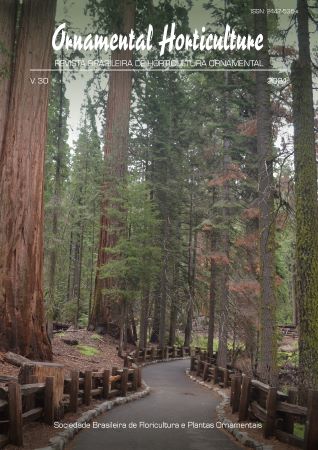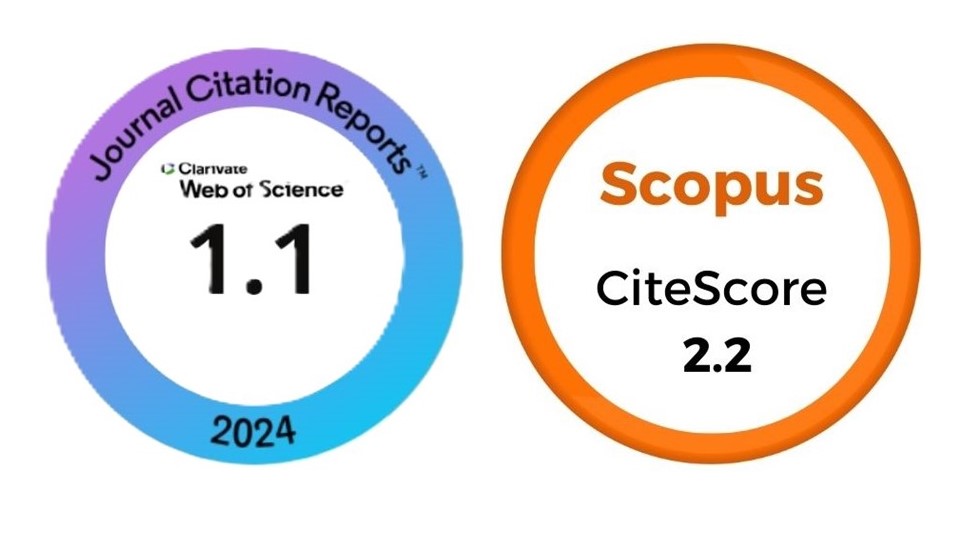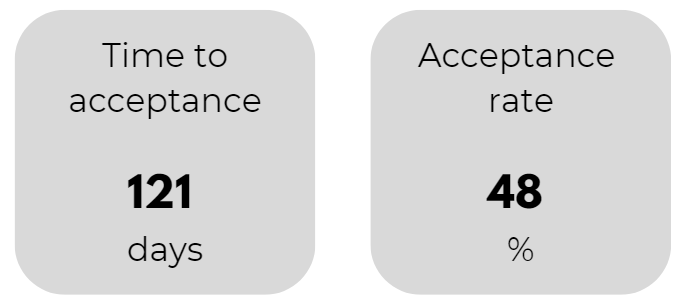Physiological and biochemical characterization of a susceptible carnation (Dianthus caryophyllus L.) cultivar to Fusarium oxysporum f. sp. dianthi (Fod)
DOI:
https://doi.org/10.1590/2447-536X.v30.e242750Keywords:
carnation, chlorophyll α fluorescence, flavonoids, leaf temperature, phenolic compounds, stomatal resistanceAbstract
The susceptibility of carnations (Dianthus caryophyllus L.) to infection by Fusarium oxysporum f. sp. dianthi (Fod) poses a significant challenge to agricultural production, particularly in Colombia, a country that is a global leader in carnation exportation. This study focused on the physiological and biochemical responses of a highly susceptible carnation cultivar ‘Solex’, to the presence of Fod to better understand the underlying mechanisms of susceptibility and to enhance early disease detection strategies in carnation crops. At the biochemical level, we analyzed the content of phenolic compounds and flavonoids in roots and stems; and we assessed physiological parameters such as foliar photosynthetic pigment content, stomatal resistance, maximum photochemical efficiency of PSII (Fv/Fm) and leaf temperature. Our research unveiled a marked decrease in metabolite production in the roots of carnation plants inoculated with Fod that was particularly evident at 4 post-inoculation days. Furthermore, we observed an early increase in leaf temperature from 1 post-inoculation day onwards, without changes in stomatal closure dynamics over time. Additionally, we recorded a significative decline in Fv/Fm, photosynthetic pigment content and dry biomass production in Fod-inoculated plants during the symptomatic phase of vascular wilting that contrasted starkly with pathogen-free controls. These findings underscored the intrinsic susceptibility of carnation plants to Fod infection, with significant implications for enhancing plant resistance and developing effective vascular wilting management strategies in crops of this flower.
Downloads
References
ARBELÁEZ-TORRES, G.; CALDERÓN, O.L.; CEVALLOS, F.; GONZÁLEZ, D. Determinación de las razas fisiológicas de Fusarium oxysporum f. sp. dianthi en clavel en la sabana de Bogotá. Agronomía Colombiana, v.10, n.1, p.19-27, 1993. https://revistas.unal.edu.co/index.php/agrocol/article/view/21227
ARDILA, H.D.; MARTÍNEZ, S.T.; HIGUERA, B.L. Levels of constitutive flavonoid biosynthetic enzymes in carnation (Dianthus caryophyllus L.) cultivars with differential response to Fusarium oxysporum f. sp. dianthi. Acta Physiologiae Plantarum, v.35, n.4, p.1233-1245, 2013. https://doi.org/10.1007/s11738-012-1162-0
BADR, A.; BRÜGGEMANN, W. Comparative analysis of drought stress response of maize genotypes using chlorophyll fluorescence measurements and leaf relative water content Photosynthetica, v.58, (SI), p.638-645, 2020. https://doi.org/10.1146/annurev.arplant.59.032607.092759
CALDERÓN, R.; NAVAS-CORTÉS, J.A.; LUCENA, C.; ZARCO-TEJADA, P.J. High-resolution airborne hyperspectral and thermal imagery for early detection of Verticillium wilt of olive using fluorescence, temperature and narrow-band spectral indices. Remote Sensing of Environment, v.139, p.231-245, 2013. https://doi.org/10.1016/j.rse.2013.07.031
CHÁVEZ-ARIAS, C.C.; GÓMEZ-CARO, S.; RESTREPO-DÍAZ, H. Physiological, biochemical and chlorophyll fluorescence parameters of Physalis peruviana L. seedlings exposed to different short-term waterlogging periods and Fusarium wilt infection. Agronomy, v.9, n.5, p.213, 2019. https://doi.org/10.3390/agronomy9050213
DEVAPPA, V.; ARCHITH, TC. Wilt diseases of ornamental crops and their management. In: BHATTACHARYYA, B.N.; CHAKRABORTY, R.N.; PANDEY, D.S.; DUBEY, SC. (Eds.), Wilt Diseases of Crops and their Management. New Delhi, India: IPSDIS, 2019.
DI, X.; TAKKEN, F.L.W.; TINTOR, N. How phytohormones shape interactions between plants and the soil-borne fungus Fusarium oxysporum. Frontiers in Plant Science, v.7, p.1-9, 2016. https://doi.org/10.3389/fpls.2016.00170
DONG, X.; LING, N.; WANG, M.; SHEN, Q.; GUO, S. Fusaric acid is a crucial factor in the disturbance of leaf water imbalance in Fusarium-infected banana plants. Plant Physiology and Biochemistry, v.60, p.171-179, 2012. https://doi.org/10.1016/j.plaphy.2012.08.004
DONG, X.; XIONG, Y.; LING, N.; SHEN, Q.; GUO, S. Fusaric acid accelerates the senescence of leaf in banana when infected by Fusarium. World Journal of Microbiology and Biotechnology, v.30, n.4, p.1399-1408, 2014. https://doi.org/10.1007/s11274-013-1564-1
FRANCESCONI, S.; HARFOUCHE, A.; MAESANO, M.; BALESTRA, G.M. UAV-Based Thermal, RGB imaging and gene expression analysis allowed detection of Fusarium head blight and gave new insights into the physiological responses to the disease in durum wheat. Frontiers in Plant Science, v.12, p.1-19, 2021. https://doi.org/10.3389/fpls.2021.628575
GARCÍA-RUIZ, H.; SZUREK, B.; VAN DEN ACKERVEKEN, G. Stop helping pathogens: engineering plant susceptibility genes for durable resistance. Current Opinion in Biotechnology, v.70, p.187-195, 2021. https://doi.org/10.1016/j.copbio.2021.05.005
GÓRECKI, T.; SMAGA, Ł. fdANOVA: an R software package for analysis of variance for univariate and multivariate functional data. Computational Statistics, v.34, n.2, p.571-597, 2019. https://doi.org/10.1007/s00180-018-0842-7
GORSHKOV, V.; TSERS, I. Plant susceptible responses: the underestimated side of plant-pathogen interactions. Biological Reviews, v.97, n.1, p.45-66, 2021. https://doi.org/10.1111/brv.12789
HIGUERA, B.L.; EBRAHIM-NESBAT, F. Study of vascular root responses as defense mechanisms in carnation resistant or susceptible to Fusarium oxysporum f. sp. dianthi by transmission electron microscopy. Acta Horticulturae, v.482, p.101-108, 1999. https://doi.org/10.17660/ActaHortic.1999.482.14
LOZANO-MONTAÑA, P.A.; SARMIENTO, F.; MEJÍA-SEQUERA, L.M.; ÁLVAREZ-FLÓREZ, F.; MELGAREJO, L.M. Physiological, biochemical and transcriptional responses of Passiflora edulis Sims f. edulis under progressive drought stress. Scientia Horticulturae, v.275, 2021. https://doi.org/10.1016/j.scienta.2020.109655
KUMUDINI, B.S.; JAYAMOHAN, N.S.; PATIL, S.V.; GOVARDHANA, M. Primary plant metabolism during plant–pathogen interactions and its role in defense. In: AHMAD, P.; AHANGER, M.A.; SINGH, V.P.; TRIPATHI, D.K.; ALAM, P.; ALYEMENI, M.N. Plant Metabolites and Regulation Under Environmental Stress. New York: Academic Press, 2018. p.215-229.
MARÍN-ORTIZ, J.C.; HOYOS-CARVAJAL, L.M.; BOTERO-FERNANDEZ, V. Detection of significant wavelengths for identifying and classifying Fusarium oxysporum during the incubation period and water stress in Solanum lycopersicum plants using reflectance spectroscopy. Journal of Plant Protection Research, v.59, n.2, p.244-254, 2019. https://doi.org/10.24425/jppr.2019.129290
MARTÍNEZ-GONZÁLEZ, A.P.; COY-BARRERA, E.; ARDILA, H.D. Extraction and analysis of apoplastic phenolic metabolites in carnation roots and stems (Dianthus caryophyllus L). Revista Colombiana de Química, v.51 n.1, p.3-13, 2022. https://doi.org/https://doi.org/10.15446/rev.colomb.quim.v51n1.99258
MEENA, K.S.; RAMYABHARATHI, S.A.; JONATHAN, E.I. Interaction of Meloidogyne incognita and Fusarium oxysporum in carnation and physiological changes induced in plants due to the interaction. SAARC Journal of agriculture, v.14, n.1, p.59-69. 2016. https://doi.org/https://doi.org/10.3329/sja.v14i1.29576
POLI, A.; BERTETTI, D.; RAPETTI, S.; GULLINO, M.L.; GARIBALDI, A. Characterization and identification of Colombian isolates of Fusarium oxysporum f. sp. dianthi. Journal of Plant Pathology, v.95 n.2, p.255-263, 2013. DOI: https://doi.org/http://www.jstor.org/stable/23721516
PÉREZ-MORA, W.; MELGAREJO, L.M.; ARDILA, H.D. Effectiveness of some resistance inducers for controlling carnation vascular wilting caused by Fusarium oxysporum f. sp. dianthi. Archives of Phytopathology and Plant Protection, v.54, n.13-14, p.886-902, 2021. https://doi.org/10. 1080/03235408.2020.1868734
PÉREZ-MORA, W.H.; CASTILLEJO, M.Á.; JORRÍN NOVO, J.; MELGAREJO, L.M.; ARDILA, H.D. Thiamine-induced resistance in carnation against Fusarium oxysporum f. sp dianthi and mode of action studies based on the proteomics analysis of root tissue. Scientia Horticulturae, v.323, 2024a. https://doi.org/10.1016/j. scienta.2023.112549
PÉREZ-MORA, W.; MELGAREJO, L.M.; ARDILA, H.D. Response of susceptible carnation cultivars during thiamine application as inducer of resistance to vascular wilting caused by Fusarium oxysporum f. sp. dianthi. Ornamental Horticulture, v.30, n.e242633, p.1-7, 2024b. https://doi.org/10.1590/2447-536X.v30.e242633
RASOOL, N. Plant Hormones: role in alleviating biotic stress. London: IntechOpen, 2022.
ROMERO-RINCÓN, A.; MARTÍNEZ, S.T.; HIGUERA, B.L.; COY-BARRERA, E.; ARDILA, H.D. Flavonoid biosynthesis in Dianthus caryophyllus L. is early regulated during interaction with Fusarium oxysporum f. sp. dianthi. Phytochemistry, v.192, 2021. https://doi.org/10.1016/j.phytochem.2021.112933
SANTOS-RODRÍGUEZ, J.; COY-BARRERA, E.; ARDILA, H.D. Mycelium dispersion from Fusarium oxysporum f. sp. dianthi elicits a reduction of wilt severity and influences phenolic profiles of carnation (Dianthus caryophyllus L.) roots. Plants, v.10, n.7, p.1447, 2021. https://doi.org/10.3390/plants10071447
TORO-TOBON G.; ÁLVAREZ-FLÓREZ, F.; MARIÑO-BLANCO, H.D.; MELGAREJO, L.M. Foliar functional traits of resource island-forming nurse tree species from a semi-arid ecosystem of La Guajira, Colombia. Plants, v.11, p.1723, 2022. https://doi.org/10.3390/plants11131723
VANEGAS-CANO, L.J.; MARTINEZ-PERALTA, S.T.; COY-BARRERA, E.; ARDILA-BARRANTES, H.D. Respuestas tempranas en simplasto de tallo asociadas a la ruta del ácido salicílico en la interacción clavel (Dianthus caryophyllus, caryophyllaceae)- FOD (Fusarium oxysporum f. sp. dianthi). Acta Biológica Colombiana, v.27, n.2, p. 153-163, 2022b. https://doi.org/https://doi.org/10.15446/abc.v27n2.85778
VANEGAS-CANO, L.J.; MARTÍNEZ-PERALTA, S.T.; COY-BARRERA, E.; ARDILA-BARRANTES, H.D. Plant hormones accumulation and its relationship with symplastic peroxidases expression during carnation-Fusarium oxysporum interaction. Ornamental Horticulture, v.28, n.1, p.49-59, 2022a. https://doi.org/10.1590/2447-536X.V28I1.2412
VILLARREAL-NAVARRETE, A.; FISCHER, G.; MELGAREJO, L.M., CORREA, G.; HOYOS-CARVAJAL, L. Growth response of the cape gooseberry (Physalis peruviana L.) to waterlogging stress and Fusarium oxysporum infection. Acta Horticulturae, v.1178, p.161-168, 2017. https://doi.org/10.17660/ActaHortic.2017.1178.28
WANG, M.; LING, N.; DONG, X.; ZHU, Y.; SHEN, Q.; GUO, S. Thermographic visualization of leaf response in cucumber plants infected with the soil-borne pathogen Fusarium oxysporum f. sp. cucumerinum. Plant Physiology and Biochemistry, v.61, p.153-161, 2012. https://doi.org/10.1016/j.plaphy.2012.09.015
WANG, M.; SUN, Y.; SUN, G.; LIU, X.; ZHAI, L.; SHEN, Q.; GUO, S. Water balance altered in cucumber plants infected with Fusarium oxysporum f. sp. cucumerinum. Scientific Reports, v.5, n.1, p.7722, 2015. https://doi.org/10.1038/srep07722
WANG, Y.; WU, J.; YAN, J.; GUO, M.; XU, L.; HOU, L.; ZOU, Q. Comparative genome analysis of plant ascomycete fungal pathogens with different lifestyles reveals distinctive virulence strategies. BMC Genomics, v.23, n.1, p.1-11, 2022. https://doi.org/10.1186/s12864-021-08165-1
WILSON, S.K.; PRETORIUS, T.; NAIDOO, S. Mechanisms of systemic resistance to pathogen infection in plants and their potential application in forestry. BMC Plant Biology, v.23, n.1, p.1-13, 2023. https://doi.org/10.1186/s12870-023-04391-9
ZHU, F.; XI, DH.; YUAN, S.; XU, F.; ZHANG, D.W.; LIN, H.H. Salicylic acid and jasmonic acid are essential for systemic resistance against tobacco mosaic virus in Nicotiana benthamiana. Molecular Plant-Microbe Interactions, v.27, n.6, p.567-577, 2014. https://doi.org/10.1094/MPMI-11-13-0349-R
Downloads
Published
Issue
Section
License
Copyright (c) 2024 Ornamental Horticulture

This work is licensed under a Creative Commons Attribution 4.0 International License.








